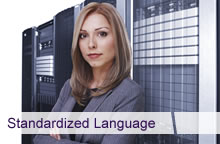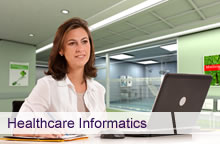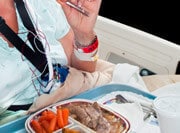The Academy of Nutrition and Dietetics (AND) defines nutrition informatics as: “the effective retrieval, organization, storage and optimum use of information, data and knowledge for food and nutrition related problem solving and decision making.”
Informatics
Informatics
Informatics
Definition: The AND also says, “Informatics is supported by the use of information standards, information processes and information technology.” (Nutrition Informatics)
Wikipedia offers a similar definition of informatics as follows: “Informatics includes the science of information, the practice of information processing, and the engineering of information systems. Informatics studies the structure, algorithms, behavior, and interactions of natural and artificial systems that store, process, access and communicate information.”
The movement towards an electronic health record (EHR), along with ongoing forces to improve patient safety and operational efficiencies, drive a push towards informed decision-making powered by healthcare technologies.
Applications
Beyond Automation

The ADA lists these areas for application of nutrition informatics:
- Foodservice systems management
- Inventory management systems
- Educational/instructional/data intake
- Communication
- Nutrient analyses
- Nutrition research
- Clinical nutrition care
- Reimbursement for nutritional care
Informed Decisions
Making Informed Decisions

- Collecting and storing data, as in a patient records database
- Applying information models for querying the data and using algorithms (formulas and logic in computer programming) to generate meaningful information
- Creation of standards and systems to support meaningful use of information

- Designate standards to identify what data mean, or what is out of range
- Apply algorithms or mathematical scoring models to quantify nutrition risk
- Access the data as part of a system to identify patients who may benefit from nutritional intervention
- Make well-informed decisions that affect healthcare outcomes for patients
A further application of informatics identifies trends and opportunities, allowing the manager to improve systems and processes. HACCP is an excellent example, as one of the seven steps of HACCP is to validate the food safety system. If you collect food temperatures routinely and house this data electronically, later you can use software to report on trends and associations. This can pinpoint areas of the food service operation where system refinements may be warranted, or measure the success of food safety initiatives already in place.
Informatics applies to quality management in food and nutrition services as well. Satisfaction ratings and survey data can be mined and transformed to determine trends, associations, needs, and opportunities.
In the nutrition arena, nutrient data lays a relevant foundation for informatics. How do you apply the basics of a nutrient database to meaningful menu planning and personalized patient care? When the patient menu software calls on the nutrient database, applying rules to ensure optimal nutrient intake, we are again in the realm of informatics.
Informatics has applications to all aspects of food service management and nutritional care. According to the ADA, the basic model requires applying standards, processes, and technologies to data. The outcome is information, the kind of information that supports sound decisions.
EHR
The EHR & Clinical Nutritional Care


HL7 standards for the electronic exchange of healthcare data are key to data aggregation and functionality of full-blown informatics systems.
ADA
ADA Standardized Language


Vision Software is a leader and innovator in healthcare informatics, having pioneered the first real time interface for A/D/T, order entry, laboratory, and pharmacy data in 1987, and the first nutrition risk screening system in 1991. At Vision, we believe in informatics… it’s more than just software™.








